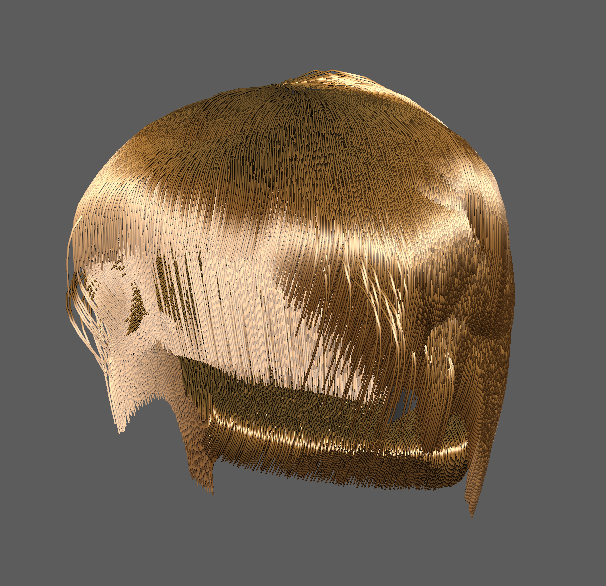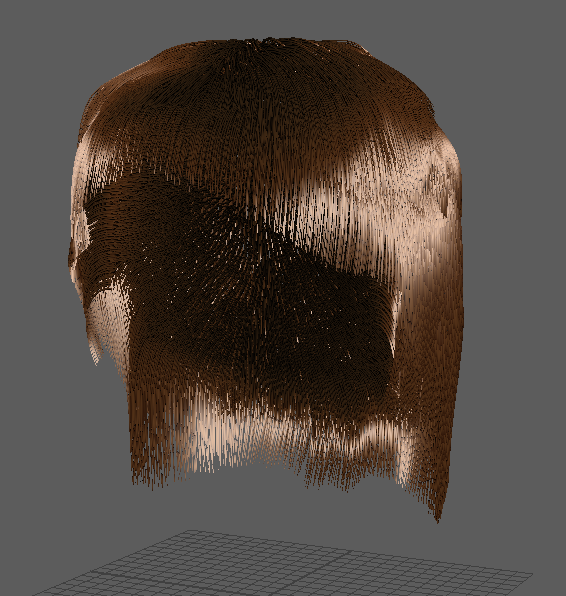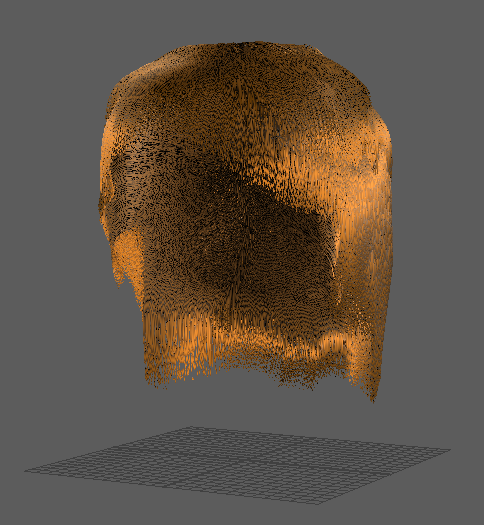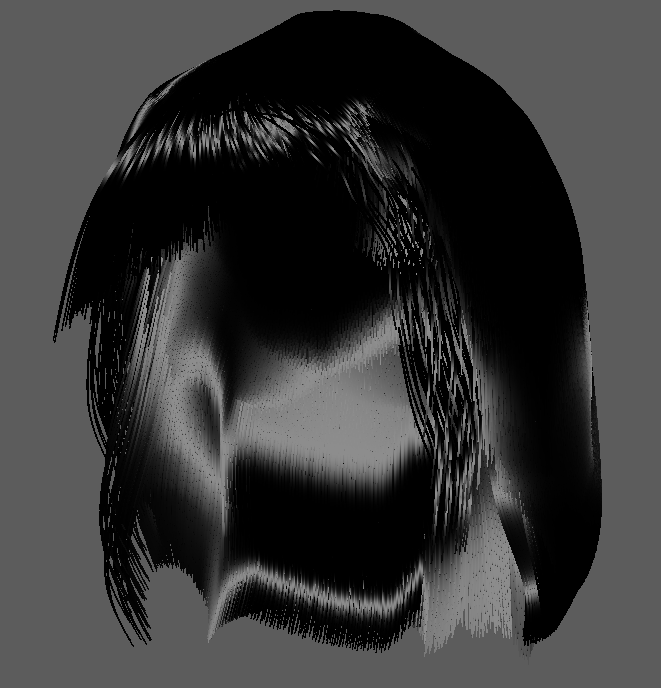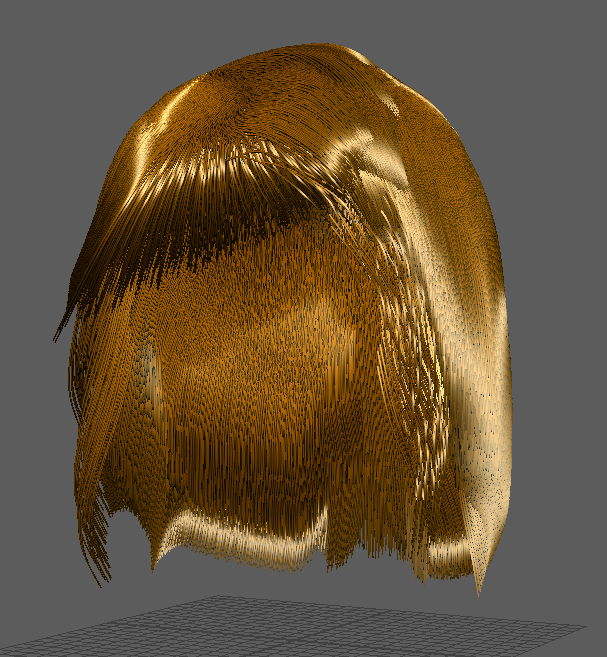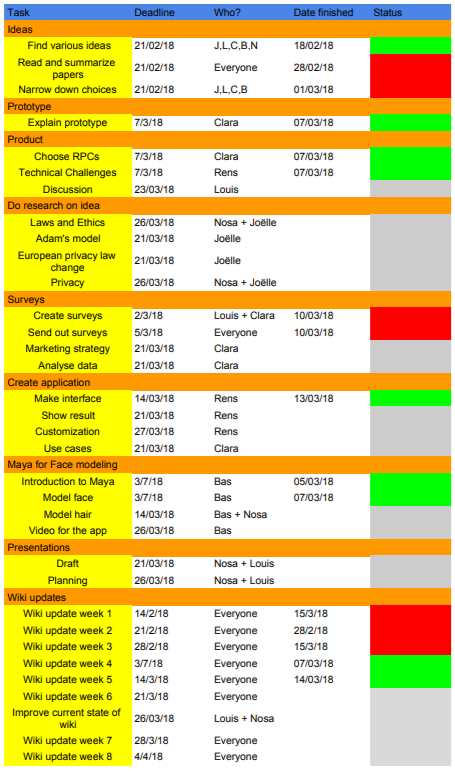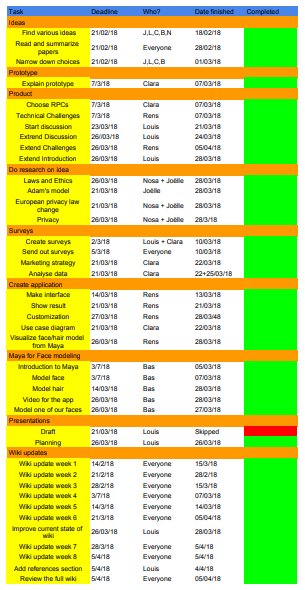PRE2017 3 Groep18
This page describes the group's effort at planning, logging and noting the meetings. Our product specific page can be found at Clairvoyance.
To go to Coaching questions page click here.
Group members
Joëlle Bink - 0992628
Louis Bonnaire - 0981196
Bas van Oorschot - 1014209
Clara Butt -1275801
Rens van Dijk - 0864724
Nosa Dielingen - 1023912
Week 1
Meet the group members
Louis: Studied a year of Software Science in 2015. Switched to Psychology and Technology, now in second year of PT. I have some experience with Java, Python, CSS, Javascript, Arduino, Stata. French, but mostly studied in English so I can also help on documentation, writing. Decent at presenting.
Clara: Mechanical engineering Master. Can code C++, Python, Matlab, C. Worked on image recognition before. Knows a bit about neural networks, Caffe, Datasets, Json.
Joëlle: Currently in the second year of Biomedical Engineering. I don’t have a lot of experience with programming, only in Python, but I’m very interested and would like to learn more.
Rens: Last year of Software science. Experience with low-level, high-level and webscale code. Also did some data science and machine learning for my job.
Bas: Second year Mechanical Engineering student. Lots of experience with practical group work. Since I'm a mechanical engineer, I know a lot about mechanics and dynamic, control of systems and some flow mechanics. I worked with arduino once, but I'm not too good at it. I can work with matlab pretty well.
Nosa Dielingen: Second year Electrical Engineer. I can program C and Arduino and a couple other languages. Furthermore building a circuit is almost second nature when having Google.
What has been done in week 1?
In week 1 all the teammates had to come with 5 ideas in order to allow for a brainstorming process as well as to be able to take elements of each other's ideas. From these 5 main ideas were chosen as potential final ideas.
One of the ideas that were chosen was a furniture displacement robot to arrange furniture in an optimal way for different circumstances. This robot would also rearrange a room if something had been displaced such that users don't have to do it themselves.
Another idea is a wellness application for which should help the user to improve its life and reach personal goals. It would adapt itself to the user's needs, time schedule and location.
A third idea we thought about was a VR bodysuit which can be worn by the user, optionally with a VR headset. The user would then receive haptic feedback depending on what happens in the virtual environment in which they are visualizing. The use of this technology would be mainly in the entertainment industry for video games as well as movies, but also for army training or martial art training.
A cooking or tasting robot which could detect the chemical composition of an inserted sample and display it, recommend similar recipes as well as share a small sample across different machines.
The final idea was that of an augmented reality mirror which could alter reality, in the same way, that augmented reality works. There were many uses for this technology and could help out through different presentations of reality as well as previews of selected options.
Week 2
For the five ideas, a rubric was made in order rate the different ideas, such that we can make an objective choice for the best idea. The two subjects have been chosen. A Smart Mirror which alters user's appearance and a house system that places all the furniture in their spot and is able to find objects that have been lost. At the end of week 2, one of the two subjects will be chosen.
Paper
In week 2 we have collected papers which can be used to gain knowledge about our subject. Below links to the papers can be found. Only the links about the Smart mirror have been added as it was the final idea that was chosen.
Smart Mirror
Dynamic Hair Manipulation in Images and Videos.[1]
This paper describes that high-resolution image manipulation is doable but that it is much harder to use in a video because of issues of depth and extravagant hairstyles. However simple video manipulation is doable.
Computer Vision.[2]
This book on 3D modelling explains how using multiple images from different viewpoints we can recreate images as well as know their depth. Useful for both the mirror idea or the home robot(furniture moving). Contains a lot of algorithms and extensive information about the different types of image/video reconstruction or alterations (600+ pages). This is more to be used in the future if we want to make it. Contains an extensive list of sources that can be relevant too.
Automating Image Morphing using Structural Similarity on a Halfway Domain. [3]
This article explains that using specific points in images and two distinct images we can create a morph from one image to another. This can be interesting when trying to make someone look different/better, by using a standard image and morphing slightly based on another image. Currently only works on images and thus not on video, but together with other research could be interesting.
I like those glasses on you, but not in the mirror: Fluency, preference, and virtual mirrors.[4]
A very relevant paper about different effects of a mirror in a shop. This article details the idea that people prefer their image in the mirror to their actual image and that acquaintances prefer how you look face to face over your reflection in the mirror. This is because someone who is familiar with you is more likely to have seen you from face to face rather than as a reflection in the mirror and thus the reflection seems unfamiliar and thus unusual.This is based on a previously done study.
Furthermore, it hits on how virtual mirrors already exist in different forms, but not in the way we want to use them. You can, for example, upload a picture of yourself to some makeup or glasses companies where they will return an image including how their product would look on you. Moreover, it claims that “neither virtual mirror technology itself nor its potential as a basic research tool has received much attention in consumer research.”. It focusses on fluency processing (how easily a visual cue can be processed by someone) and explains the different variables for fluency. It concludes that it increases aesthetical pleasure for the perceiver. It then goes on to explain that processing facilitation creates positive affect and activates smiling muscles. Then conducts an experiment to test people prefer people they do or don’t know in the mirror versus face to face. The results favour seeing someone face to face with familiar people and are indistinguishable from either case with strangers.
Reversed facial images and the mere-exposure hypothesis.[5]
This paper elaborates on the fact that people prefer how they themselves look in the mirror, while they prefer the appearance of their friend over the friend's reflection in the mirror.
Mind at ease puts a smile on the face: Psychophysiological evidence that processing facilitation elicits positive affect.[6]
When the appearance of something or someone is easier for people to process it elicits a positive affect towards said person or object. This is a basis for the idea of aesthetics and the concept of beauty.
Large Pose 3D Face Reconstruction from a Single Image via Direct Volumetric CNN Regression.[7]
State of the art AI technique for reconstructing facial meshes from 2D pictures (and videos). Does so by using volumetric CNNs. Can be used in our product to prevent having to use expensive depth cameras. When we have these meshes, we can transform them according to some beauty standard (for example make people's faces thinner, their eyes bigger, etc.)
Photorealistic Facial Texture Inference Using Deep Neural Networks.[8]
Generates facial textures from 2D images. These facial textures can be used for "photoshopping" purposes (we can egalize skin, remove blemishes, change skin and eye colour (ethics!!)). After having performed our automatic photoshopping we can project the textures back onto our mesh (see above).
An objective system for measuring facial attractiveness.[9]
A study attempting to design a model to measure facial attractiveness. Explains that facial attractiveness is universal and people from all cultures and backgrounds rate faces in a similar way.
Image Ethics in the Digital Age.[10]
A book discussing the dangers of images in the modern age. Touches on subjects such as the spread of images through the internet and media as well as the effect of image manipulation.
Cultural Standards of Attractiveness: A Thirty-Year Look at Changes in Male Images in Magazines.[11] A study which examines images of male bodies in popular magazines between 1967 and 1997. It concludes that there was a dramatic increase in leanness and muscularity from the 60s to the 80s and then declining slightly in the 90s. Can be used for appearance improvements.
Judging Physical Attractiveness.[12]
A study which aims to determines which specific body parts and functions young adults consider physically attractive, and how they relate to various self-esteem functions. For this college students rated the attractiveness of people of the same and opposite sex. It ends up concluding that there is symmetry in the attractive body parts and functions between men and women.
Face Detection Technology Based on Skin Color Segmentation and Template Matching.[13]
A paper on a new face detection method using "YCbCr chrominance space". Has a high success rate.
Snapchat patents
In 2015 Snapchat bought the company Looksery, which uses technology very related to our purposes.
METHOD FOR REAL-TIME VIDEO PROCESSING INVOLVING CHANGING A COLOR OF AN OBJECT ON A HUMAN FACE IN A VIDEO[14]
METHOD FOR REAL-TIME VIDEO PROCESSING INVOLVING CHANGING FEATURES OF AN OBJECT IN THE VIDEO[15]
METHOD FOR REAL-TIME VIDEO PROCESSING FOR CHANGING PROPORTIONS OF AN OBJECT IN THE VIDEO[16]
First detects faces by using the Viola-Jones algorithm. Then fits a face shape model to the faces (Active Shape Model). Then it transforms this model to the Candide-3 model, a popular low-computation face mask/mesh. Which then can be used for actually transforming the faces.
Week 3
During the tutor session of week 2, we were told to focus on a single idea and to be sure what our final product would be. During 3 we decided to focus on the "Augmented reality mirror" idea and therefore started looking at the multiple uses this device could have. We figure the device could be very useful in the setting of tattoos, hairdressers, in the beauty sector or for plastic surgery previews.
We then looked at the different stakeholder for each of the ideas in order to display the various parties involved in our product. Different applications of the product came with different stakeholder in the private sector, e.g. Hairdresser, tattoo parlors, surgeons.However, they were all impacted by the users and the government.
Week 4
A new main page was created for the product page which can be found on Clairvoyance
Rens
Waiting for Clara to finish the RPC’s in order to figure out the technical (research) side of the app. Found a website for generating a 3D model from a single picture. Updates the product wiki with research and will write a demo/prototype/wizard-of-oz description. Extended the requirements. Will work on prototype after tutor meeting.
Nosa
Will update wiki with existing apps/products and writes the introduction.
Joëlle
Did research in the field of ethics & laws. Found information on the Adams' model, which is a model that can be used when dealing with privacy factors in multimedia information sharing context. Updated the wiki and checked for unstructured sentences.
Bas
The task Bas was assigned to in week 4, and probably will be assigned in upcoming weeks, was working on the 3D-model of different types of hairstyles suited for different kinds of heads. These 3D-models will be modelled as a static object which can be placed over ones' head when a 3-model of this head has been made. A big part of the likeability of the system relies on whether the system is capable of showing a representative haircut, so a rather large amount of effort must be put into creating these digital haircuts.
The question of what a representative haircut is, already poses several difficulties. First of all is the matter that each head has a different shape, and thus would ideally require a different model. Next, a haircut is a very dynamic object, which can take many shapes, even during a single day. The question remains which one of those shapes is representative. Last is the question whether an image of the haircut just after the visit to the barbershop is desired, or an image of the hair after several weeks since in the question of what is representative, the latter might be more useful.
As said, haircuts are very complex and dynamic objects. Modelling such a difficult haircut thus won't be easy. After looking for different ways in which haircuts, or 3D-images in general, can be modelled, the group chose Maya to be a suited program. Although the group, and Bas in particular, has more experience with more technical-oriented software, such as Siemens NX or AutoCAD, these programs gave too little freedom in the sense of human-like modelling. Maya is a rather complicated and sophisticated software, so in order to get a good sense of how to model a haircut, Bas spent a lot of time this week learning how to model basic things in Maya. The level of modelling required to model a 3D haircut has not yet been achieved, but a good basis has been made.
Louis
Created user-survey
Clara
Because of her economical background Clara was responsible for strategy building. This includes a strategy of designing the product, selling it and for the marketing. In this week she did research on identifying user needs by a survey and building a product concept based on that.
Furthermore she developed surveys based on her results and the so called Conjoint Analysis. These surveys should identify the user value of each function of the product. One survey was send out to 114 hairdressers, one to 100 potential private users.
After that she designed the RPC’s for the prototype.
Questions for tutor
Evaluate protoype description.
Wiki page for the product structure
- Introduction
- Existing work
- Research
- Existing apps/products
- User Survey
- Requirements Preferences Constraints
- Prototype Description (Wizard of Oz)
- Laws and Ethics
Week 5
During week five each group member went more in-depth in their work done in week four.
Bas
Finished practicing with face modeling and is now working on hairstyles.
Clara
Clara evaluated the survey for private users. Based on the results she made a Conjoint Analysis, which gave detailed feedback on the user value of all product functions. After that she developed a product strategy. She determined priorities for the technical development and tried to find ways to increase the external variance while decreasing the internal variance.
She also evolved a selling concept. This concept maximised the receipts through buyers, advertisement and data analysis.
Las but not least she read beauty blogs, fashion magazines and pinterest trends to find out which haircuts will be fashionable in 2018. Those haircuts build the basis for the 3D models Bas created.
Joëlle
Continued performing research in the field of ethics & law. In order to be a truthful and ethical engineer, privacy concerns and other user issues have to be taken seriously, also for our concept. Our concept must follow the Dutch Data Protection Act (Wet bescherming persoonsgegevens, Wbp). This act outlines and emphasizes the amount of care needed when handling a customer's personal data. Also, did research on the new law: ‘Algemeen verorderning gegevensbescherming’ (AVG). This law tells us how to ensure customer safety and privacy.
Louis
Made edits to the wiki.
Nosa
Was asked to review apps that use the same technology. Downloaded apps, theorized how they worked and came to the conclusion that this didn't help the project in any way.
The apps were or to advanced to actually copy the technology from, looking at snap chat, to make a face model will be diffecult to replicate.
Or the apps were just not good, like changing the hair colour by using a brush.
Rens
Started app development. Basic UI for camera created and 3D model viewer implemented. TODO: model textures, UI for changing hair.
Week 6
Bas
In week 6, Bas continued on modelling the different types of hairstyles. Bas encountered some problems with the modelling of these styles. To explain this problem properly, a swift explanation of how the hair is modelled can be helpful.
First, a geometry of a scalp or a head is taken. In our case, this scalp is a premade male scalp found online. Next, a set of so-called guides is placed on the scalp, which, as the name suggests, guide the hair into the position the modeler wants it to be. The more guides are used, the better Maya will understand how the intended hair path flows. If all guides are placed and formed so that all of the skin on the head is covered in a fashionable manner, a hair preview can be made in Maya. Maya uses the guides as input for the hair modelling and draws the hair without knowing the intentions of the modeler. It is thus inevitable that the hair will not be correct the first time. One of the first steps to take when a primary preview is created, is to set boundaries on the surface on which the hair grows to indicate at what point the hair stops coming out of the head. Most of the time, these boundaries only have to be set on the forehead, since the imperfections on the rest of the scalp will be covered by hair. The next step in modeling our hair is fine-tuning the guides used to make the initia preview. After this step, the hair is modelled in shape, but still looks like a collection of tubes stuck to a head. To solve this problem, we can set the hair parameters such as thickness, taper, taper start and length to make the hair look more natural. The last step in editing the hair is to colour it in a desired way. Shade, tip colour and glance colour can all be accounted for in this stage.
The problem Bas encountered was, that to make sure the hair looks natural, a lot of different and well-placed guides are needed. Normal hair has a natural tendency to fluff, even when it is just placed into position. Even though Bas tried to make the hair look as natural as possible, there is only limited time left in the course, so Bas decided to leave the 'fluffs' aside for now and make the hair look rather straight. If necessary, more guides and thus more details can be added in the future to make the haircuts appear more natural.
Clara
Because most apps fail on account of bad marketing, 6 Clara did research on app marketing with focus on social media marketing. She build a marketing strategy for the future product. This involves a thoroughly approach for social media including all plattforms and current trends. She also considered the psychological aspects of marketing.
Joëlle
Continued improving the wiki by reading through all parts and editing minor mistakes. Also, critically looked at important information for possible end users in the field of privacy, for example: May images or customer information be shared on social media? What are the rules concerning this topic? What if the user is under the age of 18?
Louis
Finished off the planning for the course as can be seen below. The orange rows are topics and the yellow rows underneath are the tasks required for the topic above. For each task there is a deadline, it says who is working on this task and when the task was completed and it indicates whether the task was completed on time or not using red (late), green (on time) and grey (in progress) colours. The planning will be updated as time goes.
- Previous unfinished group work from the wiki has been updated.
Some of the papers we had to look for in week 1 weren't summarised, so I read through them and added a description. This was not done for the German sources which Clara will do before the final deadline.
- Pictures have been added for a more pleasant and visual read through the wiki.
These are the pictures used to give an idea of our initial ideas.
- The discussion has been started with the necessary steps that should be taken in order to get to the final product. These are steps we won't be able to achieve due to lack of time and technological development in some areas.
This includes bullet points for each of the relevant missing parts.
Nosa
Having looked into the legal issues of having a database with information from people, the following results have been found.
It determines what kind of information it is. When it is personal information the law is strict about it, but when the data is a picture that has been taking in a public place, the law doesn't how the information has to be stored.
Furthermore, the ones responsible for how the information is stored is us, the creators of the app.
The information that we request from our users and store are:
- The first and last name of the user;
- Their username such that a profile can be created;
- A password to secure the data such a measurement of security is met;
- And pictures that the user takes with the hairstyle that they have chosen.
The law states that the user has to give permission that the information provided can be stored. This can be done with the help of a disclaimer that explains that by using the app, a profile is made and that the data is stored in our database.
The main concerns, for privacy, were the picture, but because the pictures are made in a public place, namely the hairdresser salon, the pictures can be stored and used by us. Furthermore, if the hairdresser decides to also take pictures and store them, this is also allowed.
Rens
Added a toolbar to the app. Updated prototype description.
Week 7
Bas
- Presentation
Worked on making the presentation as well as present it with Louis.
- Hairstyles
Finished off the final hairstyles.
Clara
Clara established the styling options found in the app. This section is an easy way to increase the external variance without touching the internal one. She casted the most well-known beauty bloggers on YouTube, which had the same haircut as Bas modelled. Then she extracted pictures of the videos, wrote a little description to each of them and prepared them for the app. Furthermore she added the tutorial links.
After that Clara developed a Use-Case-Diagram based on UML norms.
She also put all results of the last weeks including pictures and sources in the wiki and structured her wiki parts. Furthermore she prepared what Louis and Bas should present of her part.
Joëlle
Extended and improved the texts in the discussion part, also added what can be done if we were to set this project forth in the future. Summarized the laws & ethics part so that it could be presented during our presentation.
Louis
- Extended the discussion
Elaborated on the different points of the discussion, reformatted it such that it looks better.
- Updated coaching questions
Added a couple of lines where possible.
- Extended the introduction
Added text to the introduction which gives a better idea of what our product is and how it is useful.
- Updated the planning
Added finished task dates and added missing tasks for the final weeks.
- Grammar and structure
Went through the updated parts and checked grammar and formatting.
- Worked on presentation
Prepared and presented it with Bas. Others helped to prepare it by sending content on the parts they worked on.
- Added links at the top of the page to easily go to each of the three pages
Nosa
Planned to interview hair dresser and to pitch the prototype and final idea. Plan to have a casual conversation where there is a honest opinion about the product and not purely focused on if it will sell for us or not but that the user, in this case the hair dresser, actually sees him or herself using the product because it's profitable.
Rens
Implemented the hair models that Bas made inside the app. Implemented Clara's effort at hairstyling suggestions.
Week 8
Bas
Clara
Despite a lot of mails, we could only get a few responses on the survey for hairdressers. Because of that we had to collect responses over and over again, call hairdressers or visit them. That is why the survey results could only be exploited at the very end of the project. Clara evaluated the results and adapted it to the existing marketing and product strategy.
Joëlle
Extended and improved the texts in the discussion part, also added what can be done if we were to set this project forth in the future. Again, checked other texts for improvements, added to them and fixed spelling/grammatical mistakes.
Louis
- Converted all the references to APA.
Required formatting changes and conversion
- Updated planning.
The various tasks were updated and so was the last column in the planning for clarity. It now shows whether the task is complete or not.
- Updated coach questions.
The final coaching questions were answered.
Nosa
Interviewed 5 hair dressers and has put the result into the wiki.
Rens
Updated the technical challenges section of the wiki.
Coaching
References
<references \>
- ↑ [1] Chai, M., Wang, L., Weng, Y., Jin, X., & Zhou, K. (2013, 07). Dynamic hair manipulation in images and videos. ACM Transactions on Graphics, 32(4), 1. doi:10.1145/2461912.2461990
- ↑ [2] Hartley, R., & Zisserman, A. (2004). Multiple view geometry in computer vision. Cambridge University Press.
- ↑ [3] Vu, A. (n.d.). A computer vision system for automatic knowledge-based configuration of the image processing and hierarchical object recognition. Proceedings 10th International Conference on Image Analysis and Processing. doi:10.1109/iciap.1999.797668
- ↑ [4] Cho, H., & Schwarz, N. (2010, 10). I like those glasses on you, but not in the mirror: Fluency, preference, and virtual mirrors. Journal of Consumer Psychology, 20(4), 471-475. doi:10.1016/j.jcps.2010.07.004
- ↑ [5] Mita, T. H., Dermer, M., & Knight, J. (1977). Reversed facial images and the mere-exposure hypothesis. Journal of Personality and Social Psychology, 35(8), 597-601. doi:10.1037//0022-3514.35.8.597
- ↑ [6] Winkielman, P., & Cacioppo, J. T. (2001). Mind at ease puts a smile on the face: Psychophysiological evidence that processing facilitation elicits positive affect. Journal of Personality and Social Psychology, 81(6), 989-1000. doi:10.1037//0022-3514.81.6.989
- ↑ [7] Jackson, A. S., Bulat, A., Argyriou, V., & Tzimiropoulos, G. (2017, 10). Large Pose 3D Face Reconstruction from a Single Image via Direct Volumetric CNN Regression. 2017 IEEE International Conference on Computer Vision (ICCV). doi:10.1109/iccv.2017.117
- ↑ [8] Saito, S., Wei, L., Hu, L., Nagano, K., & Li, H. (2017, 07). Photorealistic Facial Texture Inference Using Deep Neural Networks. 2017 IEEE Conference on Computer Vision and Pattern Recognition (CVPR). doi:10.1109/cvpr.2017.250
- ↑ [9] Bashour, M. (2006, 09). An Objective System for Measuring Facial Attractiveness. Plastic and Reconstructive Surgery, 118(3), 757-774. doi:10.1097/01.prs.0000207382.60636.1c
- ↑ [10] Gross, L. P., Katz, J. S., & Ruby, J. (2003). Image ethics in the digital age. University of Minnesota Press.
- ↑ [11] Law, C., & Labre, M. P. (2002, 09). Cultural Standards of Attractiveness: A Thirty-Year Look at Changes in Male Images in Magazines. Journalism & Mass Communication Quarterly, 79(3), 697-711. doi:10.1177/107769900207900310
- ↑ [12] Franzoi, S. L., & Herzog, M. E. (1987, 03). Judging Physical Attractiveness. Personality and Social Psychology Bulletin, 13(1), 19-33. doi:10.1177/0146167287131002
- ↑ [13] Aiping, C., Lian, P., Yaobin, T., & Ning, N. (2010). Face Detection Technology Based on Skin Color Segmentation and Template Matching. 2010 Second International Workshop on Education Technology and Computer Science. doi:10.1109/etcs.2010.465
- ↑ [14] S., E., M., & Y. (2015, August 06). CROSS-REFERENCE TO RELATED APPLICATIONS. Retrieved from http://www.freepatentsonline.com/y2015/0221069.html
- ↑ [15] S., & E. (2015, August 06). CROSS-REFERENCE TO RELATED APPLICATIONS. Retrieved from http://www.freepatentsonline.com/y2015/0221118.html
- ↑ [16] S., & E. (2015, August 06). CROSS-REFERENCE TO RELATED APPLICATIONS. Retrieved from http://www.freepatentsonline.com/y2015/0222821.html


